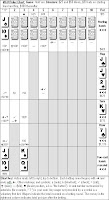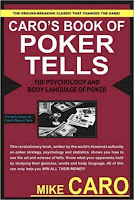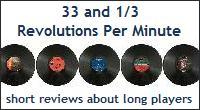Keeping Score
 When I was a kid I watched a lot of baseball. Collected cards, scored the games, bought yearbooks, and all the rest. Loved it. Then other stuff came along that had the effect of lessening my interest considerably. Stuff like free agency. Huge salaries. Girls.
When I was a kid I watched a lot of baseball. Collected cards, scored the games, bought yearbooks, and all the rest. Loved it. Then other stuff came along that had the effect of lessening my interest considerably. Stuff like free agency. Huge salaries. Girls.Before all that, though, I’d always get a copy of Bill James’ Baseball Abstract each preseason and read and reread the sucker all year. James is a long time baseball writer who specializes in various kinds of statistical analyses. James called his discipline “sabermetrics” (after the Society for American Baseball Research or SABR). Was responsible for all sorts of innovative ways of analyzing players’ performances, including inventing certain stats like “runs created” and “power/speed numbers” and the like.
I was scrounging around in the attic yesterday looking for those Abstracts. Came up empty, though I’m sure they are around somewhere. Hope I find them, as there should be a dozen or so complete sets of cards in the near vicinity, I’m guessing. I wanted to find the one with an essay proposing a new kind of box score, one that provided more detailed information than the relatively sparse ones we used to get in the sports page every morning. (Box scores have changed considerably since then, partially because of James’ influence, I think it is safe to say.)
Looking online I’m seeing the article I’m looking for was probably the one titled “Project Scoresheet.” Besides introducing a new kind of box score, James was also hoping to recruit fans from around the country to help compile data from all games in a more thorough way than was being done in the early 80s. (This was way before the internet, dontcha know.)
After a bit more hunting online, I see that James’ “Project” indeed was successful and continued through 1991, after which James joined a group called STATS, Inc. (“Sports Team Analysis and Tracking Systems”) that tracks statistics for other sports, too. He also apparently was hired by the Boston Red Sox a few years back as a consultant.
Why was I interested in such stuff? Well, I happened to have grabbed Mike Caro’s Caro’s Book of Poker Tells off the shelf the other day and as I was rereading I found myself recalling James’ Abstracts.
Caro and James have certain qualities in common, I think. Both are analytical thinkers, and both in their writings can be found time and again explicitly trying to be iconoclastic or innovative or whatever adjective you want to use for someone who is not satisfied with simply rehearsing “received wisdom.”
 In fact, as those of you who have read the Book of Poker Tells no doubt recall, Caro (like James) there introduced a new kind of “box score” or way of recording poker hands. In the book he explicitly (vainly?) expresses a desire that his “MCU Poker Charts” become “universally accepted” as the standard for conveying a poker hand. (“MCU” stands for the fictitious “Mike Caro University” from which emanate all of Caro’s seminars, writings, etc.) If you click on the picture you can see a larger version the chart, if yr curious.
In fact, as those of you who have read the Book of Poker Tells no doubt recall, Caro (like James) there introduced a new kind of “box score” or way of recording poker hands. In the book he explicitly (vainly?) expresses a desire that his “MCU Poker Charts” become “universally accepted” as the standard for conveying a poker hand. (“MCU” stands for the fictitious “Mike Caro University” from which emanate all of Caro’s seminars, writings, etc.) If you click on the picture you can see a larger version the chart, if yr curious.The charts work well enough in the book, although obviously they never really came close to becoming the “standard” for recording and conveying all of the information from a poker hand. In fact, they are probably too busy and non-intuitive, although when reading the book one gets used to them easily enough. No surprise, really, that the “Charts” never really came close to becoming any sort of standard.
 In fact, one kind of gets the feeling Caro himself didn’t really have a lot invested in the idea of the “MCU Poker Charts.” I can’t find them anywhere on his website, nor are Word documents with the charts available on planetpoker.com (as even the most recent edition of Caro’s book promises).
In fact, one kind of gets the feeling Caro himself didn’t really have a lot invested in the idea of the “MCU Poker Charts.” I can’t find them anywhere on his website, nor are Word documents with the charts available on planetpoker.com (as even the most recent edition of Caro’s book promises). I like Caro and would be one of those who’d argue he’s made significant contributions to poker over the years, the most significant being the way he helped shaped players’ awareness and analyses of physical tells. Them “Poker Charts,” though, are somewhat less significant, although I’ll give Caro some credit for drawing attention to the fact that when reporting poker hands one needs to be as thorough as possible.
Labels: *by the book, baseball, Bill James, Caro's Book of Poker Tells, Mike Caro














3 Comments:
Great post. I too am a baseball geek and have some of James' books.
They definitely shaped my understanding of the game.
-PL
Greetings from another baseball geek. FYI, Ken Burns is adding another "Inning" to his "Baseball" documentary to cover recent times. Sports Illustrated has the story.
Count me in as one of those influenced by James writing when I was a teenager.
I went on to dabble in sabermetrics myself. For some time I collaborated with entities such as Baseball Primer (now Baseball Think Factory) and The Hardball Times.
I consider the latter to be the gold standard for accessible, sabermetric-inspired baseball writing.
Post a Comment
<< Home